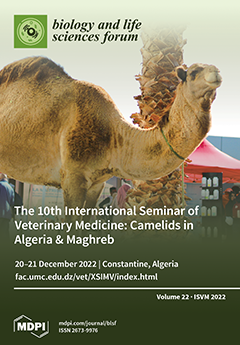Camel milk is a valuable food choice, representing a primary need in the diet of people in dry zones. Camel milk is rich in nutrients, which makes it a favorable environment for the development of microorganisms.
Staphylococcus and
Listeria are significant opportunistic pathogens
[...] Read more.
Camel milk is a valuable food choice, representing a primary need in the diet of people in dry zones. Camel milk is rich in nutrients, which makes it a favorable environment for the development of microorganisms.
Staphylococcus and
Listeria are significant opportunistic pathogens in humans, dairy cattle, and camels. The presence of these bacteria could present a potential public health issue. In the present study, 20 milk samples collected from camel farms in M’sila were investigated for the presence of
Staphylococcus spp. and
Listeria spp.
Staphylococcus enumeration, and a search for
Listeria spp. was performed according to the recommendations of ISO 6888-1(2004) and ISO 11290-1(2017) methods, respectively. The results show a contamination prevalence of 62% of
staphylococcus spp. with an estimated average bacterial load of 2.7.102 cfu/mL, while for
Listeria spp., only three samples were positive, with a prevalence of 14.28%. For each species, identification using API
Listeria strips confirmed the presence of
Listeria grayi,
Listeria innocua, and
Listeria seeligeri species, but no Listeria monocytogenes were recovered in these samples. According to the current results, we could conclude that the percentage of contamination with
Staphylococcus in the tested camel milk samples was relatively high compared to the level of contamination with Listeria. There is no Algerian regulation setting microbiological criteria for raw camel milk; however, these results suggest that the hazard to the consumer cannot be excluded.
Full article



